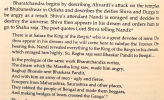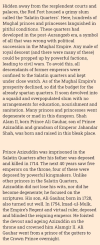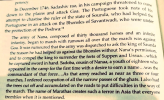Marathas were first Indian rulers to recognize the threat posed from European Navies and so despite their main enemies were land based Deccan Sultanates and Later on Mughals, they still invested heavily in navy and coastal forts. Their remnants still exist all over western konkan coast of Maharashtra.
https://30stades.com/2022/05/01/mah...of-kingdoms-on-indias-west-coast-architecture
All built and gained from proceeds of looting and pillaging campaigns and no more important than a fleet of small pirate boats. Maratha territory itself was not a wealthy agricultural region by any means, which was the main indicator of wealth and economy in those days. Hence the need for looting faraway places which were much more agriculturally and economically prosperous, such as Bengal.
What Hindutvas should do is study the Mughal Navy under Bengal Sultanate which was way larger than Shivaji's naval force which was nothing more than a bunch of small coastal pirate ships.
None of the kingdoms or empires in North or South India had a BLUE WATER NAVY.
Cholas, Chalukyas or Marathas had naval fleets but these cannot be defined as Blue water navy but can be compared to COAST GUARD or MERCHANT NAVY roles.
Yes all the Indian kingdoms of yore had some sort of Merchant Naval Fleet which traded with Arabia, Iran, Eastern Africa, Zanzibar, Malay Peninsula, Vietnam , Laos, Cambodia, Thailand, Java and other Islands of Indonesia.
Cholas and Chalukyas attacked, interfered militarily (and opportunistically) in Malay Peninsula, Java, Srilanka, Maldives, Muscat etc. but that does not make these navies BLUE WATER NAVIES.
Mughals had a Merchant Fleet which carried on Trade and carried Passengers to HAJ from port of SURAT and a medium sized cannon-armed fleet to protect these merchant vessel from Pirates.
The Maratha navy was nothing more than a pirate fleet as recalled by later historians with the minor character of SAMBHAJI an Indian pirate.
-------------------------------------------------------------------------------------
The first Mughal called Babur founded the Mughal dynasty after the First Battle of Panipat in 1526. His age was nearly 42 years then. He died 4 years later in 1530. He didn’t have enough time to expand the empire up to the seas within 4 years.
The life of Humayun had many ups and downs. Though Humayun was the successor of Babur his brothers wanted to capture for themselves. Internal conflicts with his half-brother Kamran Mirza and the attack from Sher Shah Suri forced him to flee to Persia. Sher Shah’s untimely death and help of the Persian ruler helped Humayun to regain his throne after 15 years. When he regained his throne, he was 45 years old and he died just some months later. He didn’t get time to expand his territories to the seas.
When Humayun died, Akbar was the Viceroy of the provinces of Hindal and Ghazni. After Humayun’s death, Akbar was declared the emperor by his loyal Bairam Khan. Later, when Akbar wanted to reclaim Punjab from Sikandar Shah Suri, Hemu declared himself as the independent Hindu emperor and claimed Delhi. After the shocking defeat of Hemu in the Second Battle of Panipat, Akbar conquered Delhi and from then, started expanding his empire.
This is Akbar’s empire during the time of his death:-
The only coastal regions the Mughal empire had during this time were the coastal regions of Gujarat on West and coastal regions of Bengal. The region which lies on the Bengal map is covered by the Sundari forests of Bengal, which is a great hurdle in creating a port. So, even though a great coastline of Bengal came under Mughal Empire, only some portion of the coastline was suitable for making port (This was of course Chittagong which supplied ships to both Ottoman and British navies).
Since ancient period, Bengal had a glorious tradition of boat and ship building. Traditional ship and wooden boat were made in Chittagong. The Moroccan traveler
ibn batuta who came to Bengal in the 14th century saw numerous boats in the river carrying men and merchandise and testified to the existence of gigantic fleet of war-boats. According to the European Traveler Caesar Frederick, Chittagong was the center of building ocean-going vessels in the mid 15th century. In the 17th century, the ship building institutions of Chittagong are reported to have built a complete fleet of war-boats for the Uthmaniyah (Ottoman- Osmanlı padişahları) Sultan of Turkey. During the Mughal period, Bengal is said to have taken the lead in building ships and boats.
Fleet built for Ottoman navy in Chittagong bay, which has been a shipbuilding center of excellence since time immemorial.
Mughal-
Arakanese battle on the banks of the
Karnaphuli River in 1666 - near Chittagong port.

en.wikipedia.org
The Mughal Empire didn’t have direct control over these coastal regions. Often, the local rulers were allied under Akbar’s dominance. These ports were under the control of these rulers (such as the Bengal Sultanate) which the Mughals could use if needed.
This is the map which compares the empire established by Akbar and the empire extended by his successors:-
Jehangir was the fourth Mughal. There are numerous accounts on Jehangir. Some historians say that Jehangir was an able administrator who had settled many disputes started by his father and had formed a co-alliance with other rulers who accepted the Mughal supremacy when awarded with favorable posts in the Mughal courts. Some historians say that Jehangir was a man who didn’t give much attention towards his empire. He used to spend his time on drinks, luxury and romance. It was his consort Nur Jahan who controlled all the affairs of the empire.
Shah Jehan and Aurangzeb expanded their empire and a larger coastline came under their empire. However, these coastlines weren’t totally under the control of the Mughal Empire. These were directly under the local rulers who had alliances with the Mughals (such as Ilyas Shahi dynasty - i.e. the Bengal Sultanate).
The Mughals did have a substantial navy - unlike Shivaji's fleet of pirate boats. It started when Gujarat and Bengal came under the empire of Akbar. The Mughal Navy was founded by Akbar and he used the ports of Gujarat and Bengal for his navy.
The most common ship of the Mughal navy was the “Ghurab” which was a galley.

en.wikipedia.org
The Ghurabs were mainly shallow draft war boats which also carried cannons. Other than Ghurab, there were:-
- Bachari, designed on the structure of a fishing trawler.
- Jung, designed on the features of a merchant ship.
- Balam, designed based on a cargo-carrier.
The above ships were based on designs of civilian ships. Apart from these ships, the Mughals had Jalba or Jalliya, which were much like galliots from the Mediterranean Sea. Other than these, Akbar introduced the galley called kosa - which were large coastal armed ships popular in Bengal. Then there was Khelnas which were more like scout boats used for carrying messages and small troops.
There were armed riverine fleets which the Mughal used to invade Dhaka against the Ilyas Shahi dynasty.
Mughals believed in building monuments rather than expanding their navy. A navy needs money, experienced sailors and management. Mughals did not commit to invest in manpower and skillful administration to control or maintain a navy from Delhi. The later Mughal emperor like Jehangir and Shah Jahan considered it easier and feasible to use the naval facilities of their coastal friends rather than expanding and developing their own navy.
Although not an effective blue water navy, brown water actions by the Mughal forces were important, and brown water operations are often forgotten in Western accounts for whom naval warfare is about Hornblower-type events. [1]
The Mughal Empire was a land empire, so ships were much less important than for the maritime empires of Portugal, Spain or Britain. Mughal ships lacked the firepower of Western vessels, so European vessels dominated the seas of South Asia.
In 1658, Aurangzeb ascended the Mughal throne at Delhi. Mir Jumla was made governor of Bengal. He seems to have possessed a significant navy, made up of boats procured from remote places in Bengal. In 1661-62, Mir Jumla used his fleet also to conquer Assam.
Aurangzeb built up his navy to compete with vessels of the Portuguese (with whom he formed an alliance) and those of Arakan whom the Mughals fought. Mughals sailed up the river and made an attack also by land, which led eventually to the sinking off several Arakanese ships by gun-fire or ramming, the capturing of the Arakanese fleet with 132 war-vessels, with guns, armaments and elephants and the conquest of Chatgaon (Chittagong) in 1666.
- Black J (2009) Naval Power- History of Warfare at Sea from 1500, ISBN 978-0230202801
- More J B P Bengal Navy and the First Anglo-Mughal Confrontation in the Age of Globalisation,
- Solvyns, Balthazar (2001). Hardgrave Jr., Robert L. (ed.). Boats of Bengal: Eighteenth Century Portraits of Balthazar Solvyns. New Delhi: Manohar. ISBN 9788173043581.





















